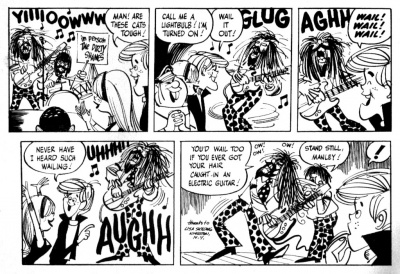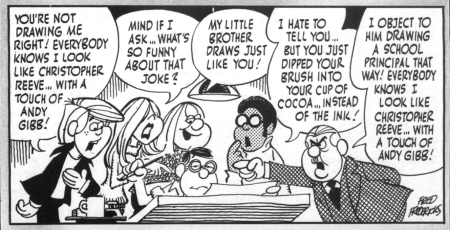Spotlight on Fred Fredericks - Other Comics - Rebel

| |
| Country: | |
|---|---|
In 1964, Fred Fredericks learned about a new magazine called "Scholastic Scope," which was set to be distributed in schools across the United States. Excited about the opportunity, he presented some of his artwork to the Scope headquarters. As a result, the comic strip "Rebel" came into being. For nearly three decades, Fredericks diligently created the strip, and it was also compiled into collections for wider readership.
An interesting aspect of the creative process was that some strip ideas were inspired by gags and suggestions sent in by the public. Whenever kids wrote in with their humorous ideas, Fredericks credited them within the comic strip itself. This interactive element not only engaged the readers but also gave them a sense of participation in the making of "Rebel."
Comic strip story
"Rebel" is a series centered around a group of teenagers who spend time together, with some jokes revolving around life at Finster High School and others taking place during their leisure time.
Throughout the series, Frederiks never explicitly mentions the grade or age of these teenagers. However, given that high school typically spans four years, namely Freshman, Sophomore, Junior, and Senior years, some clues can be inferred from the context. For instance, Mr. Mellon warmly greets the group at the beginning of the school year and knows them by name, suggesting that they are not freshmen. Similarly, at the end of the school year, there's an indication that they will return to school after the summer break, ruling out the possibility of them being seniors. Additionally, Rebel is shown driving a car in several strips, implying that he must be at least 16 years old. This aligns with a strip from March 31, 1977, where Rebel encounters someone who bullied him in first grade, which would have been around the age of 6 or 7. The strip indicates that this event took place ten years ago, supporting the notion that Rebel and his friends are likely 16-17 years old and juniors in high school.
Despite the passage of time in the series, the characters don't seem to visibly age. The first strip of each school year suggests the start of a new year, while the last strip of the school year indicates its conclusion. However, the characters consistently remain juniors, starting and ending each school year at the same grade level.
Main characters
Rebel is the central character of the series, but little has been revealed about his background and upbringing by Fredericks. Although it's mentioned that he has parents, there's no mention of any siblings. It's unclear whether Rebel's first name or surname has been disclosed, leading one to assume that "Rebel" is a nickname. One of his notable interests is music, and he has a peculiar taste in it. In the early years, he occasionally performed on stage with a band comprising of himself, Hare, and Groover.
Before 1970, Hare was known by his nickname "Wreck" and is one of Rebel's closest friends, making regular appearances throughout the strips. Fredericks has provided some additional background for Hare, including the presence of his father in a few strips. Furthermore, Hare has a younger sister named Sis and a little brother named Claude.
Celeste frequently appears in the strips, and though she occasionally goes on dates with Rebel, their relationship doesn't appear to extend beyond friendship. Her father, Mr. Cascer, also makes appearances but doesn't seem particularly enthusiastic about Rebel. Celeste has a younger brother as well, and an interesting detail is that she is drawn with her hair covering her eyes, similar to how Beetle Bailey's eyes are never shown by Mort Walker.
Groover plays a more passive role in the strips. He's a recurring character, but most of the jokes do not actively involve him. Fredericks hasn't provided any details about his background.
Mr. Mellon serves as the principal of Finster High School, and aside from Celeste, he's the only person whose full name is known - Walter Mellon. However, Frederiks has not delved deeper into his background either. As the principal, Mr. Mellon struggles to understand the teenagers and their thoughts. Additionally, he has blind faith in the school's large computer, even believing it's Halloween if the computer says so, regardless of the actual date.
The school computer tends to be uncooperative and often acts like a wise guy.
Other characters
- Miss Ridley, a teacher, is in several stripes.
- Mr. Cascer, father of Celeste, is in several stripes.
- The Coach, is in several stripes.
- Big Ernie, the school bully, is mentioned several times but is not drawn in any panel.
- Mr. Herkimer, a teacher, figures in one (?) strip.
- Mr. Brookshear, a woodworking teacher, figures in one (?) strip.
- Darth Vader (character in the Star Wars franchise) is a substitute teacher in algebra II in the strip of November 17, 1977.
- Lance Templeton, cameo appearances in the strip of May 2, 1986
Scholastic Scope
Scholastic Scope is a magazine designed for high school students. From its inception, each issue has featured the humorous comic strip "Rebel" by Fred Fredericks.
The magazine's first issue was published in autumn 1964, and it covers the school year from September to May, with a release frequency that alternates between weekly and fortnightly. Typically, 24 issues are published during a school year. Initially, the magazine followed different semesters, with Volume One published from September to January 1964, and Volume Two covering the spring months until May 1965. However, this changed in the autumn of 1976, when the entire school year became Volume 25.
During the school year 1989-90, there were two double issues (5-6 and 17-18), resulting in only 22 "Rebel" strips being printed. Interestingly, the first issue for the year 1990-91 did not include a "Rebel" strip but featured a one-panel strip titled "Today's Fresh Phrase" by Fredericks. This strip showcased a humorous take on the phrase "Freshly dipped" - Meaning: nicely dressed, as in "He looks freshly dipped today." Additionally, readers were encouraged to submit their slang words or phrases along with their definitions. Fredericks had experimented with a similar concept in 1983 when he illustrated the book "The New York Times Captive Vocabulary" by Robert Greenman.
However, the new idea of the "Today's Fresh Phrase" strip didn't seem to resonate with the readers, and subsequently, a new "Rebel" strip reappeared in Issue 2 but was absent in Issue 3. After that, the "Rebel" strip had an irregular publication schedule, appearing in issues 4, 5, 6, 8, 9, 11, 12, and 16 (March 22, 1991).
Between the years 1964 and 1991, approximately 631 "Rebel" strips were printed in Scholastic Scope.
Samples
Cover
My Fifteen Years at Finster High by Fred Fredericks
In the issue of December 13, 1979, there is an article written by Fred Fredericks: "My Fifteen Years at Finster High by Fred Fredericks." Here he tells a little about himself and the story behind Rebel.
Back in 1964, I was drawing comic books such as Mighty Mouse, The Munsters, and Twilight Zone. That's when I heard about a new magazine called Scholastic Scope. You never know what might happen until you try. So I took some of my art over to Scope headquarters. I found that the editor was looking for an original comic strip. I worked up some samples - and Rebel was accepted. Rebel appeared in the first issue of Scope. The gang from Finster High has been in there ever since. Whenever I tell Scope readers that Finster High is a make-believe place, they say, "Oh yeah? You should see our school!" So maybe it does exist out there somewhere. After all, other Scope readers tell me they know a kid just like Rebel... or Celeste... or Groover... or Hare. Thinking up Rebel jokes can be fun. You often remember something that happened in school - or should have happened. Then you build a gag around it. Other times, you work a joke out of thin air. You might imagine what Rebel would do if his car fell apart just before it is inspected. Then the gag takes form. I also draw another comic strip called Mandrake the Magician. It appears every day in more than 200. newspapers. It is drawn in a different style than Rebel. Because it is filled with adventure, rather than humor, the art is more realistic. Many young people would like to become cartoonists. They often ask me how to work towards that. A good tip is to draw all you can in your spare time. Try to develop some cartoons for your school newspaper. The many hours of practice might pay off someday. Once, I entered the Scholastic Art Awards when I was in high school. I won a prize, which was a great thrill. I hear the same thing happened to Robert Redford. But I promise not to make any movies if he doesn't draw any comic strips.
Books
In December 1969 Scholastic Book Service released the first Rebel book, with 61 (of 120) selected strips from the years 1964 to 1969. In April 1974, the second book with Rebel was published.





